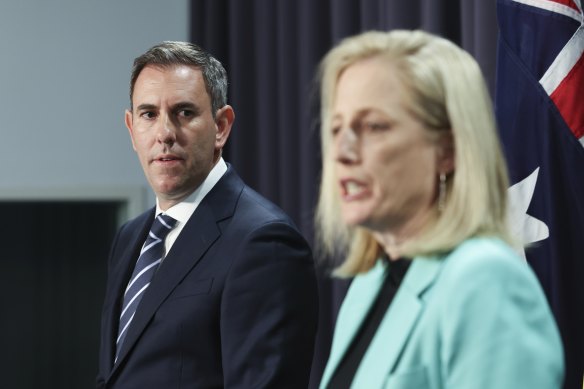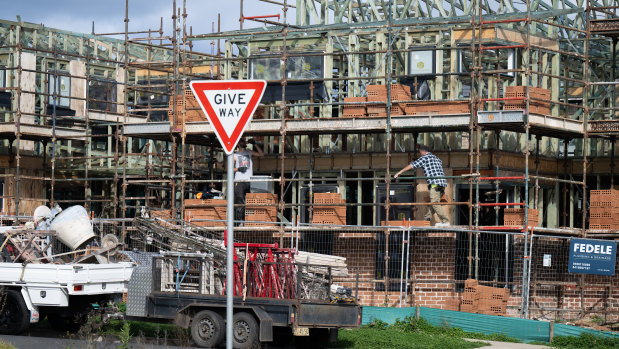This was published 9 months ago
Budget starts to show the wear and tear of a slowing economy
By Shane Wright
A sharp fall in tax revenue from workers and businesses over the past four months has exposed an emerging economic fault line ahead of the coming federal election, despite the government producing one of the largest budget surpluses on record.
As Treasurer Jim Chalmers declared he was “unconvinced” that any changes to negative gearing would boost housing supply, the final results of the 2023-24 budget showed a surplus of $15.8 billion.

Treasurer Jim Chalmers and Finance Minister Katy Gallagher reveal a $15.8 billion budget surplus, the second successive surplus.Credit: Alex Ellinghausen
The second successive budget surplus under Chalmers was $6.5 billion better than what he forecast in May. But the improvement came despite a $5.4 billion shortfall in expected taxes.
While collections from working Australians reached a record high of $331.5 billion during the just-completed financial year, this was $3.1 billion lower than what Treasury had forecast just five months ago.
Company tax collections, at an all-time high of $142.9 billion, were $1.7 billion down on the May forecast. In another sign people are cutting costs, GST revenues were also down $800 million on expectations.
Even tobacco excise, which over the past five years has been one of the government’s most important sources of revenue, was lower than forecast at $9.7 billion.
While revenue was down, spending was also lower than forecast in May, down by $10.2 billion. The government saved almost $2 billion due to a lower-than-expected demand across a range of programs including the National Disability Insurance Scheme and Covid-19 vaccinations.
Much of the rest in savings came from states not meeting milestones under various joint programs. The single largest saving, worth $1 billion, was due to Western Australia not signing a bilateral agreement with the federal government for a disabilities support program.
The budget was also helped by extra non-tax revenue, including $400 million due to better returns from the Future Fund and $300 million in extra interest.
Chalmers said across the government’s two first budgets it had improved the budget by a cumulative $172 billion and aided in its efforts to bring down inflation while making financial space for cost-of-living relief such as its energy supplement payments.
He said the government had also reduced the level of debt that the Morrison government had expected, while at the same time dealing with a slowing economy.
“We are looking for a soft landing in our economy, our fiscal strategy plays a really important
role in that, and that’s why we’re proud of the two surpluses,” he said.
Forecasts for the 2023-24 budget were first released by then treasurer Josh Frydenberg during the depths of the Covid shutdown in 2020.
At the time, he expected government gross debt to have reached more than $1.1 trillion in 2023-24 and the deficit to be at $66.9 billion. Instead, gross government debt had reached $906.9 billion while the budget bottom line was $82.7 billion better than forecast.
But shadow treasurer Angus Taylor accused Chalmers of trying to con the Australian public, as households struggled with a 9 per cent fall in their after-inflation disposable income.
“We should also be clear that this is the biggest spending, biggest taxing government in Australian history. Taxation since Labor came to power for the year just passed, is up $104 billion, receipts is up $104 billion, and the vast majority of that they have actually spent,” he said.
As a share of the economy, however, tax revenues edged down from what had been forecast to 23.7 per cent. It is the highest tax-to-GDP ratio since 2007-08, when the budget was in surplus, but is smaller than other years including 2004-05 and 2005-06 when it reached a record level of 24.2 per cent.
Commonwealth Bank chief economist Stephen Halmarick said the drop-off in both personal income and company tax collections was consistent with the slowdown in the economy, a fall in the terms of trade and a loosening of the jobs market.

Jim Chalmers says the government is not convinced changes to negative gearing will lift housing supply.Credit: Louie Douvis
Chalmers has been under pressure since this masthead revealed last week that the Treasury department had started work on options to scale back negative gearing and capital gains tax concessions.
On Monday, the treasurer effectively killed any changes, saying the government was focused on its program of supply measures rather than reforms to the tax system.
“Well, supply is our primary consideration … As the prime minister said last week, he is unconvinced and we are unconvinced of the impact on supply,” he said.
“Our focus, as I’ve said in response to all these questions, is not on negative gearing or capital
gains. The focus is on housing supply and rolling out our $32 billion of investment.”
Cut through the noise of federal politics with news, views and expert analysis. Subscribers can sign up to our weekly Inside Politics newsletter.